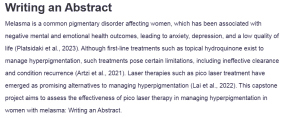Writing an Abstract
Melasma is a common pigmentary disorder affecting women, which has been associated with negative mental and emotional health outcomes, leading to anxiety, depression, and a low quality of life (Platsidaki et al., 2023). Although first-line treatments such as topical hydroquinone exist to manage hyperpigmentation, such treatments pose certain limitations, including ineffective clearance and condition recurrence (Artzi et al., 2021). Laser therapies such as pico laser treatment have emerged as promising alternatives to managing hyperpigmentation (Lai et al., 2022). This capstone project aims to assess the effectiveness of pico laser therapy in managing hyperpigmentation in women with melasma: Writing an Abstract.
The project will employ an experimental mixed-methods research design to assess pico laser therapy’s effectiveness in reducing hyperpigmentation in women with melasma. Research participants will be purposively selected with a focus on women recently diagnosed with melasma and seeking treatment. The research project will have a pre-and post-test assessment using the MASI tool to track pigmentation changes with treatment. A control group will be selected and treated with topical hydroquinone for comparison.
A post-treatment qualitative survey will also be conducted to focus on patient-reported experiences with pico laser treatment and outcomes. The project expects to record a sustained 40-57% reduction in melasma pigmentation across the patients within six months of treatment with low instances of adverse effects with the pico laser treatment compared to the topical hydroquinone-treated group. Patients are also expected to report higher levels of satisfaction with the pico laser treatment and the treatment outcomes with patient-reported improvements in their quality of life following the significant reduction in hyperpigmentation.
The findings of this project will add to the current evidence on the use of laser treatments in the management of hyperpigmentation disorders. As melasma treatment has remained a challenge in dermatology settings due to high recurrence rates with limited efficacy of topical treatments, the evidence from this project will support the use of pico laser treatment as a safe, effective, and efficient alternative to conventional treatments in managing hyperpigmentation in patients with melasma.
References
Artzi, O., Horovitz, T., Bar-Ilan, E., Shehadeh, W., Koren, A., Zusmanovitch, L., Mehrabi, J. N., Salameh, F., Isman Nelkenbaum, G., Zur, E., Sprecher, E., & Mashiah, J. (2021). The pathogenesis of melasma and implications for treatment. Journal of Cosmetic Dermatology, 20(11), 3432–3445. https://doi.org/10.1111/JOCD.14382
Lai, D., Zhou, S., Cheng, S., Liu, H., & Cui, Y. (2022). Laser therapy in the treatment of melasma: a systematic review and meta-analysis. Lasers in Medical Science 2022 37:4, 37(4), 2099–2110. https://doi.org/10.1007/S10103-022-03514-2
Platsidaki, E., Efstathiou, V., Markantoni, V., Kouris, A., Kontochristopoulos, G., Nikolaidou, E., Rigopoulos, D., Stratigos, A., & Gregoriou, S. (2023). Self-Esteem, Depression, Anxiety and Quality of Life in Patients with Melasma Living in a Sunny Mediterranean Area: Results from a Prospective Cross-Sectional Study. Dermatology and Therapy, 13(5), 1127–1136. https://doi.org/10.1007/S13555-023-00915-1/TABLES/3
ORDER A PLAGIARISM-FREE PAPER HERE
We’ll write everything from scratch
Question 
Week 7: Assignment 2 – Writing an Abstract
Resource: Writing Scientific Abstracts (Purdue Owl)
The purpose of this assignment is to write an abstract for your capstone project. The function of an Abstract is to provide a brief, descriptive summary of the essay/report. The function of an Abstract is to inform the reader of the contents of the report /essay so that the reader can see in advance the key areas covered and the main points of the argument. An Abstract clearly states the purpose and direction, the main arguments and the conclusions reached. It is a mini version of the paper. If writing an investigative report which includes research findings, then it is usual to include in the Abstract the aims or objectives, methods, findings or results, conclusions and implications.

Writing an Abstract
Your capstone abstract must be approved by the Capstone Advisor and or Faculty Chair before the final draft.
Keep these guidelines for abstracts in mind:
- Provides a professional, scholarly synopsis of the capstone project
- States the purpose of the capstone clearly and succinctly
- Provides a brief rationale for the capstone project.
- Describes the design and methodology of the main activities of the project
- Describes the expected results or the outcomes of the capstone.
- Provides a summary statement that shows the possible implication of the capstone project to student’s clinical practice setting or profession.
- Utilizes 250-300 words maximum, using 12-point font, either, Arial, Times New Roman, or Courier
Expectations
- Length: Maximum of 275-300 words
- Format: APA 7th ed.
- Research: At least one peer reviewed reference within the last 5 years
